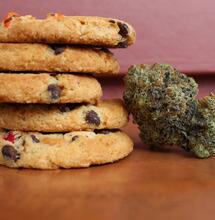From Names to Odd Research: 15 Things Bizarre About Marijuana

“OMG, this thing is the real s*hit” is a commonly used phrase, likely followed by laughter by most weed users, especially when they taste a new extra strain of weed. Used to chill with friends, better sleep at night, or simply ease the pain, the cannabis effects have been planetary popular since ancient times. But things can get weird, and we should know about them, right? Not pretending to turn this article into a boring history class, let’s explore some peculiar stories related to weed.
1. It’s in the genes
Everybody knows that hemp and weed are two different things. Researches from the University of Saskatchewan in 2011 announced that there is a genetic expression that emphasizes high cerebral sensations in psychoactive cannabis plants (Cannabis sativa). Hemp, on the other hand, is not popular or amusing among smokers. Even though industrial hemp and marijuana plants are from the same plant family, hemp does not really produce tetrahydrocannabinolic acid (THCA), which is the key chemical needed for the high. Hemp plants do not have the enzyme to produce THCA, says the same university's biochemist Jon Pageto. What is good news for hemp, then? Hemp is super productive in cannabidiolic acid (CBDA), a nonpsychoactive CBDA, which can reduce performance anxiety, enhance sensations, and reduce pain but is nowhere nearly as thrilling as a real weed. Choose your thing wisely!
2. The importance of fibers proved in action
We have all heard the story about Maoi - the monolithic human figures carved by the Rapa Nui people on Easter Island in eastern Polynesia between the years 1250 and 1500. The monuments have been the subject of countless research efforts, just like Stonehenge. One of those efforts includes an archeological project led by Professor Carl Lipo from California State University. In 2012, as Archaeological Journal published, Lipo's team worked to determine how the stones used for the statues were transported from their quarry. The researchers' theory is that Easter Islanders used hemp rope where they took the fibers from a bush very similar to marijuana plants, to make the rope. On a second look, they do look a bit stoned, don’t they?
This guy does look a bit stoned, huh.
3. Spiders high on marijuana build messy webs
Or perhaps they were just getting creative. So, yeah, some scientific research has really gone into unexplainable directions, as it's hard to determine why there would ever be the need to test species of the order Araneae how they react pumped on THC. Anyways, the research also found out spiders were easily distracted from their mission to knead the web and gave up quickly. On the other hand, spiders on LSD produced highly geometric webs, even more so than when they were sober. A word of advice: if you keep a spider as a pet, don't try to intoxicate them with weed. Give them LSD instead.
4. Marijuana vs. human health
Pros and cons about marijuana's health effects are mostly related to mental health. As a drug that affects brain activity, there is always the underlying risk in those consumers who are at risk of psychotic disorders. On the other hand, so many people actually use pot for mental health problems. Other organs of the human body aren’t excluded from the discussions. While marijuana can be great for other organs like the liver or the bowels, it might still not be the best friends with the heart. An analysis of 2,000 medical cases in France in 2014 has for instance associated he use of marijuana with heart problems. Marijuana elevates the heart rate and blood pressure, and that is why the consumption might be fatal for people with a history of heart problems.
5. Nomen est omen
“Oh, what’s a name,” said Juliet to Romeo. When it comes to the weed community, the name has great significance. All the qualities that are connected with smoking weed, whether that is happy, euphoric, uplifted, relaxed, creative, have their authentic strains with names like Silver Haze, Blueberry, or Granddaddy Purple. Sometimes the weed is called by the place of provenance, like Durban Poison, or sometimes it is because of the sweetness of the effect and the ability to make a good joint, like Cherry Pie. The tradition of naming different types of marijuana took off in the 1970s in Hawaii with Maui Waui aka Maui Waui or Mowie Wowie, a classic euphoric and joyful sativa. Who would think about names like these? Apparently, it’s a process of creative enlightenment while smoking pot and feeling creatively liberated. When the co-owners of Amsterdam's DNA Genetics, a cannabis seed bank, were asked by the LA Times in July 2014 about this matter, the answer was: "And we sit there, and we call all our friends and smoke. That's a brainstorm session."
Kush cake is relaxing, creative and euphoric, a cross between Wedding Cake and Kush Mint.
6. Every time you say marijuana, you also say brothel and prostitutes
The designation Mary Jane is a story on its own record. Beyond names of strains, cannabis itself has dozens of designations. The designation cannabis is definitely not something you’ll hear from the mouth of a person asking their dealer for some ounce. It's a rather more scientific name. Depending on where people come from in the world, some of the most common slangs are grass, pot, ganja, reefer, hash, herb. But perhaps the most popular word that even your grandma knows is marijuana. It’s considered that the name marijuana is from the Mexican slang term for cannabis, and it could have derived from the Spanish pronunciation of the names Mary and Jane. These two names are also commonly used in Mexican slang for a prostitute or brothel. So yeah, basically every time you say marijuana or Mary Jane, what you’re also indirectly unwittingly saying is brothel or prostitute.
7. The Italian phenomenon
You have to be really stoned to think that Italy is under one great marijuana cloud. Maybe on Coachella in California, but let’s be honest, Italy smells like pasta and pizza. But according to more unorthodox science research, it's not all so black and white. This tidbit of research has focused on examining the presence of psychotropic substances in the air, such as marijuana but also cocaine, nicotine and caffeine. Seven Italian cities were part of this study: Rome, Milan, Naples, Palermo, Turin, and the winners in highest air pot concentrations, Florence and Bologna. So apparently, not only the statues in the Gallery Uffizi are stoned! Not to be overly excited, this concentration of pot is not enough to make you high, but the benefit of the study is that it can also discover how much drug trafficking exists in these cities. Or better yet, it can indicate the ingesting habits of Italian, which, turns out, they're not only after innocent pizza and pasta.
8. When you detect pot in baby urine
Nobody can argue the miraculously calming effect of the smell of a newborn baby. Perhaps North Carolina went too far in their analyses when they reported that few babies were tested positive for pot in their urine in one hospital. What? Did their mothers smoke? shocking. Before this could cause any problems with the social workers and accusations for the concerned mothers, let us clarify that the babies were just very clean. Blame it on the soap! Namely, the ingredients in a few commonly used baby soaps can manifest a false presence of marijuana in urine tests. Additional research on foam baths and soaps for babies, like those from Johnson & Johnson or Aveeno, has shown that these were pot-free. So, it's not that every soap has traces of cannabis. Anyways, babies do have their inner high, and they don't need marijuana for that matter... yet.
9. Not so “green” grass
Our shared imagining of cannabis plantation may include an idyllic picture of a sunny valley, pleasant breeze, and happy young rasta farmer. Sorry to break this to you: Mary Jane is not an easy lady to maintain. Back in 2011, one researcher at Lawrence Berkeley National Laboratory made an interesting comparison stating that this plant is quite needy and greedy in terms of how much energy and electricity it sucks. His example was that 2.2 pounds (1 kilogram) of weed production inside a warehouse uses the same amount of energy a vehicle would need to cross the U.S. several times. Seems like a long road trip! Outdoor cannabis plantations cannot satisfy the annual needs, although can significantly reduce marijuana's carbon footprint—therefore, the need to manufacture weed in closed facilities. Anyways, in a perfect world, we would all just grow weed at home and would not need a high-tech industry to produce it for us.
From environment perspective, smoking a joint is still pretty innocent. There are far more toxic behaviors. Plus, if you are growing yourself, you're doing a favour to nature.
10. Marijuana vs. addiction
“I just use it after a long day at work,” “Just two-three time before bedtime,” or “ It’s only on a social occasion” are the phrases that are commonly used for casual weed users. Could this type of behavior lead to marijuana addiction, and if so, what makes one recreational user an addict? Addiction usually means that a person manifests mild to severe anxieties while quitting the drugs. According to some research, about 9 percent of marijuana users could become addicts, which is still a matter of discussion in academic circles. A 2016 study puts everything on the phylogenetic tree, especially the three genetic variants related to addictions. According to the scientist’s report in the journal JAMA Psychiatry, the variant that regulates the calcium in the blood is the one responsible for opioid dependence, and the second one is for the central nervous system. These same variants are also present in depression cases, which is perhaps the answer to why addiction and melancholy are very close friends.
11. The temperance movement once suggested weed as a substitute for alcohol.
It was a long time ago, but it still counts. During the temperance movement of the 1890s, marijuana was commonly recommended as a substitute for alcohol. The argument used for this was that, unlike alcohol, marijuana did not lead to domestic violence. There was a war of words in general on alcohol in those days. Alcohol was also associated with bankrupting and financial wrecks. It was also associated with immorality. And then came Prohibition. Unfortunately, the stance on weed as safe and healthy for consumption changed in the years after the Prohibition ended. While alcohol regained its status in society, weed lost it.
12. The first transcontinental dealing
The Eastern European Steppe, the territory that today is inhabited by the people of Ukraine, Russia and Kazakhstan, is considered to be the first place where drug trafficking occurred, one study from 2016 has suggested. Cannabis was popular on both continents Europe and (East) Asia, more or less at the equal time, between 11,500 and 10,200 years ago. The story that includes dealing cannabis begins with the Yamnaya nomad tribe 5,000 years ago when the trafficking route was rooted across the steppe. The archeologists indicate that they have discovered signs of burned cannabis, probably while the tribe moved from one place to another. Fun fact: the Yamnaya tribe may be responsible for spreading the Indo-European languages and domesticating wild horses. It must have been one hell of a weed back then! P.S. Since we are mentioning historical transactions, it's worth noting that the first online drug dealing also concerns weed.
The first e-commerce transaction was a baggie of pot, in 1972, involving Stanford students.
13. Party in the afterlife
People make all sorts of wishes while they are on their deathbeds. And some people in Asia had a really goofy perception of the afterlife. One peculiar case which has charmed scientists is of a man who was buried about 2,700 years ago in the highlands of China's Tianshan Mountains, but his bones were later transported to a graveyard in the Gobi Desert. While there must be a great story behind why the deceased's remains were transferred elsewhere, scientists were more impressed by what accompanied the man's graveyard: 28 ounces of weed (789 grams). The substance was a subject of numerous analyses, claiming that the plant with vivid green color but without the characteristic odor was used for “mystical purposes.” Furthermore, the molecular analysis confirmed the presence of cannabidiol, cannabichromene, and cannabicyclol. You can’t grow marijuana in the underworld, and this guy indeed went there well prepared. The findings of the burial were presented in the Journal of Experimental Botany in 2008.
14. Who can beat this record?
Marijuana consumers are deprived of the experience to be part of The Guinness Book of World Records. Disappointingly, but not even a single record of any quantity of grown marijuana or anything related to it. But the “Operation Tiburon,” which shocked the U.S in 1982 and which was widely reported at the time, was worth to be mentioned as a record. Namely, it was the most prominent marijuana catch ever, with 2,903 metric tons, or 6.4 million pounds coming (easy to guess) from Columbia. As part of the investigations, 495 were interviewed by the police, and as many as 95 boats were additionally checked to determine any involvement. Great movie material for Netflix!
15. Not everything is in the winning, right?
It seems that weed users are more into the game and less competitive than non-users. One research from 2016 is basically about a game where individuals compete for small monetary rewards and where scientists scan the part of the brain called nucleus accumbens. It's a small part of the brain associated with reward processes. The result was to be expected. Weed users in the research demonstrated weaker activity in the nucleus accumbens compared to other players. While researchers admit that there could be other factors influencing the weakened activity, not just only weed, there's really no need to blame weed smokers for losing. Maybe marijuana users just enjoy the game and are not so focused on winning, but rather have good times. Besides, they say a small amount of money, right? Now, after so much weed talk, it’s probably high time to roll another one.



